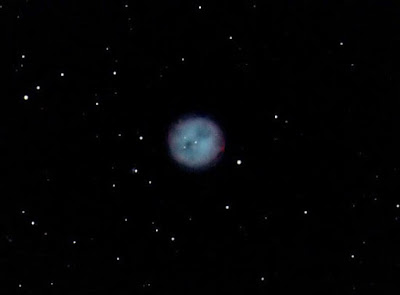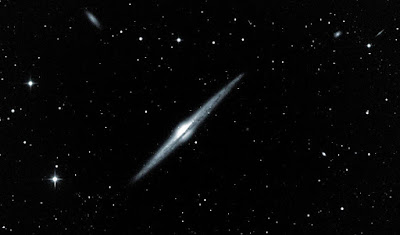 |
| Display of Galaxies Imaged by PCIS Students |
The images that the students took of galaxies, a globular cluster, and a planetary nebula are breathtaking! A large printout of the night sky, along with the students' images, is on display near the entrance of the planetarium. This hands-on experience not only taught the students a great deal about remote imaging with a telescope, but it also enabled them to grasp the profoundness of the images they captured.
Special thanks to Monica Ares, Planetarium Program Instructor, Michael Petrasko, Insight Observatory Project Developer, and Kellianne Campbell, 6th Grade Teacher at PCIS. Together, they designed this amazing opportunity for our students that they hope will grow in the years to come. Below are a few of the images the students acquired by using a 17" telescope remotely in Mayhill, New Mexico, with all image exposure times at 5 minutes. You can view all of the images the students acquired on the Insight Observatory's Image Gallery page.
 |
| M51 - Image by Mark R. & Peter H. |
The Whirlpool Galaxy (also known as NGC 5194) is an interacting grand-design spiral galaxy in the constellation Canes Venatici. Recently, it is estimated to be 15 and 35 million light-years from our own Milky Way Galaxy. The galaxy and its companion (NGC 5195) are easily observed by amateur astronomers, and the two galaxies may even be seen with binoculars under dark skies and good seeing conditions. The Whirlpool Galaxy is also a popular target for professional astronomers, who study it to further understand galaxy structure (particularly structure associated with the spiral arms) and galaxy interactions.
 |
| M97 - Image by Bianca T. & Cassidy B. |
The Owl Nebula (also known as Messier 97, NGC 3587) is a planetary nebula in the constellation Ursa Major. It was discovered by Pierre Méchain in 1781. M97 is regarded as one of the more complex of the planetaries. The 16th magnitude central star has about 0.7 solar mass, and the nebula itself has about 0.15 solar mass. The nebula formed roughly 6,000 years ago. The nebula gets its name from the appearance of owl-like "eyes" when viewed through a large 200mm telescope under dark sky conditions with the aid of a so-called "nebula filter." The eyes are also (albeit not so easily) visible in photographs of the nebula.
 |
| NGC 4565 - Image by Olivia F. & Nachelle S. |
NGC 4565 (also known as the Needle Galaxy or Caldwell 38) is an edge-on spiral galaxy about 30 to 50 million light-years away in the constellation Coma Berenices. The 10th magnitude galaxy sits perpendicular to our own Milky Way galaxy and is almost directly above the North Galactic Pole (in the same way Polaris is located above the North Pole). It is known as the Needle Galaxy for its narrow profile. First spotted in 1785 by Sir William Herschel (1738–1822), this is one of the most famous examples of an edge-on spiral galaxy. "Visible through a small telescope, some sky enthusiasts consider NGC 4565 to be a prominent celestial masterpiece Messier missed."

No comments:
Post a Comment